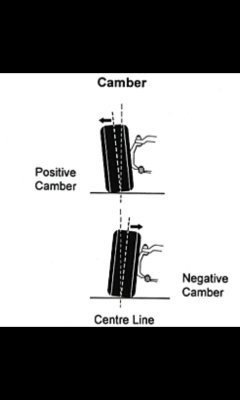
Car Suspensions: Discover the Camber
Reading Time: 4 minutes
Camber refers to the angle of the wheels relative to the vertical axis of the vehicle when viewed from the front or rear. In more easy terms, it’s the tilt of the wheels. If the top of the wheel tilts inward towards the vehicle, this is known as negative camber. Conversely, if the top of the wheel tilts outward away from the vehicle, it is referred to as positive camber.
Camber affects the vehicle dynamics: the vehicle driving dynamics is how force affected vehicle driving and comfort. The vehicle driving dynamics is divided into longitudinal dynamics and vertical dynamics, which includes driving, braking and ride comfort. The problem of driving slip and braking slip are solved by the study of vehicle longitudinal tire force, which can also improve driving and braking efficiency. The ride comfort focuses on vehicle vibration and pitch movement caused by vertical tire force.
Types of Camber
- Negative Camber: This configuration tilts the top of the wheels inward. It is commonly used in performance and racing cars because it improves handling, especially during cornering. Negative camber increases the tire’s contact patch on the road during turns, enhancing grip. Road racing front wheels setup is around -3.5° and rear wheels setup is around -2.0°
- Positive Camber: Here, the top of the wheels tilt outward. This setup is less common in modern cars but can be seen in older vehicles and some agricultural or heavy-duty vehicles. Positive camber helps with stability and steering effort, particularly in off-road conditions.
- Zero Camber: This is when the wheels are perfectly vertical. Zero camber provides even tire wear and is typically used in everyday passenger cars for a balanced performance.
How Camber Affects Car Handling
Camber angle alters the handling qualities of a particular suspension design; in particular, negative camber improves grip when cornering. This is because it places the tire at a better angle to the road, transmitting the centrifugal forces through the vertical plane of the tire rather than through a shear force across it.
The centrifugal (outwards) force is compensated for by applying negative camber, which turns the contact surface of the tire outwards to match, maximizing the contact patch area. Note that this is only true for the outside tire during the turn; on straight road only the inside tire is in contact with the road, this increasing the tyre wear.
On the other hand, for maximum straight-line acceleration, the greatest traction will be attained when the camber angle is zero and the tread is flat on the road. Proper management of camber angle is a major factor in suspension design, and must incorporate not only idealized geometric models, but also real-life behavior of the components; flex, distortion, elasticity, etc. What was once an art has now become much more scientific with the use of computers, which can optimize all of the variables mathematically instead of relying on the designer’s intuitive feel and experience.
How Camber Can Be Adjusted
- Factory Adjustments: Most modern vehicles come with factory settings that are optimized for general use. These settings are usually a compromise between handling performance, tire wear, and comfort.
- Adjustable Control Arms: These are aftermarket parts that replace the stock control arms and allow for camber adjustments. They are commonly used in performance tuning and racing applications.
- Camber Plates: Installed at the top of the strut towers, camber plates allow for precise camber adjustments. They are typically used in conjunction with coilover suspension systems and are popular in racing and high-performance street applications.
- Camber Bolts: These are eccentric bolts that replace the standard bolts in the suspension system. They allow for minor camber adjustments and are an affordable option for those looking to fine-tune their camber settings.
- Shims: Used primarily in vehicles with solid rear axles or non-adjustable suspensions, shims can be placed between the wheel hub and the axle to change the camber angle. This method is less precise and more labor-intensive than other adjustment methods.
Conclusion
Camber is a critical aspect of a vehicle’s suspension geometry that significantly influences handling, tire wear, and overall performance. Understanding the effects of camber and knowing how to adjust it can help optimize a vehicle for its intended use, whether for daily driving, competitive racing, or off-road adventures. Proper camber adjustment requires precision and sometimes specialized equipment, but the benefits in terms of improved handling and tire longevity make it a worthwhile endeavor:
- Cornering Performance: Negative camber improves cornering ability by maximizing the tire’s contact patch during a turn. When a car corners, the body rolls and the outer wheels need to handle more load. Negative camber ensures that the outer wheels maintain maximum grip, reducing understeer and improving stability.
- Tire Wear: Incorrect camber settings can lead to uneven tire wear. Excessive negative camber can cause the inner edges of the tires to wear out faster, while too much positive camber can wear out the outer edges. Proper camber adjustment is crucial for maintaining tire longevity.
- Straight-Line Stability: Positive camber can improve straight-line stability, making it easier to control the vehicle on uneven surfaces. This is particularly useful for vehicles like tractors and off-road machines, where maintaining a straight path over rough terrain is essential.
- Handling Balance: Camber adjustments can fine-tune the handling balance of the vehicle. Negative camber on the front wheels can reduce understeer (where the car turns less than desired), while negative camber on the rear wheels can mitigate oversteer (where the car turns more than desired).



